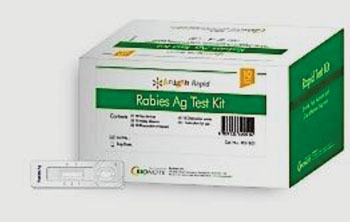Evaluation of Rapid Rabies Tests Reveals Problems with Accuracy
By LabMedica International staff writers
Posted on 06 Jul 2016
If humans bitten by a rabid animal are treated quickly, the disease can usually be prevented but such post-exposure prophylaxis is expensive and should be reserved for bites from animals with confirmed infection, but testing dogs for rabies in resource-poor settings is challenging.Posted on 06 Jul 2016
The gold standard for rabies diagnosis is the fluorescence antibody test (FAT), which requires that brain tissue is fixed on microscope slides, stained with fluorescently labelled antibodies, and examined under a fluorescence microscope. Alternative diagnostics include various assays to detect virus, antigen or viral ribonucleic acid (RNA), the latter based on polymerase chain reaction (PCR) technology. All of these tests require laboratory equipment, trained staff, and temperature-sensitive reagents.

Image: The Rapid Rabies Ag Test Kit is a chromatographic immunoassay for the qualitative detection of Rabies virus antigen (Photo courtesy of Creative Diagnostics).
Scientists at the Friedrich-Loeffler-Institute (Greifswald-Insel Riems, Germany) and their international colleagues compared six commercial lateral flow devices (LFD) for the diagnosis of rabies and their analytical sensitivity. They examined the sensitivity of the tests, their ability to exclude rabies infection accurately, as well as their specificity, which reflects an accurate positive diagnosis, in comparison with fluorescent antibody tests (FAT) and PCR in over 100 samples from experimentally infected animals and animals infected in the wild.
The investigators found that while all six tests showed good specificity, that is none gave false positives, they found that none of them demonstrated good sensitivity across the different sample sets. In fact, more than half of all positive samples, those with positive FAT and PCR results yielded "false negative" LFD results. Some LFD tests did better than others, and in some cases specific batches of the same test did better than others, but overall the results were disappointing.
The Antigen Rapid Rabies Ag-Test (Bionote Inc, Hwaseong-si, South Korea) displayed a positive rate for seven samples; the Rabies Virus Ag Rapid Test (Green Springs, Shenzhen, China) for 10 samples; the Rapid Rabies Ag Test (Creative Diagnostics, Shirley, NY, USA) for 14 samples. The scientists did report that viral RNA can be stored and eventually extracted from the LFDs using standard procedures available at molecular diagnostic laboratories. In fact, they were able to detect viral RNA after six weeks of storage at room temperature.
The authors concluded that with their current limitations commercially available rabies LFDs cannot be recommended for routine diagnosis and surveillance. If animals were involved in a biting incident to a human being, they note that false negative results may induce the patient and the doctor to refrain from appropriate post-exposure prophylaxis (PEP) given its high cost, even if the leaflet accompanying the test states that results are to be confirmed by a reference method. The study was published on June 23, 2016, in the journal PLOS Neglected Tropical Diseases.
Related Links:
Friedrich-Loeffler-Institute
Bionote
Green Springs
Creative Diagnostics














